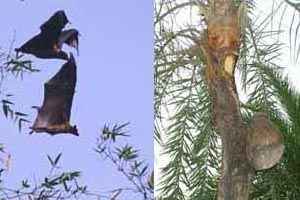The post 20 die in 4 days in Lalmonirhat appeared first on Dhaka Mirror.
]]>The Institute of Epidemiology, Disease Control and Research on Friday identified the disease that killed three more people in Lalmonirhat on the day as encephalitis, acute brain inflammation, caused by nipah virus. So far 20 people died of the disease in the place in four days, according to an unofficial figure.
The IEDCR director, Mahmudur Rahman, said, ‘After a laboratory test, we have confirmed that the people were suffering from encephalitis caused by nipah virus.’
The IEDCR, however, said 22 people were infected with the virus and 14 of them died till Friday.
Death rate of nipah virus is very high, said Mahmudur Rahman adding that three in four such patients died from the infection.
Reports from Hatibandha in the district said that more than 50 others, mostly children, contracted the disease, panicking people in the locality.
The people who died on Friday were Bacchu Mia, 57, of Baraipara, Asadul Islam, 18, of Gendukuri and Joynal, 42, of Dakkhin Goddimari in the upazila.
An eight-member IEDCR team was visiting the area. The team leader Subodh Kumar Kunda, principal scientific officer at the IEDCR, said that it is a contagious disease and has no specific treatment.
The local people on Friday morning, meanwhile, organised a human chain in front of the upazila health complex demanding immediate identification of the disease and take steps against the disease.
ASM Alamgir, senior scientific officer at the IEDCR, said there is no effective medicine or vaccine available to treat the patient infected by nipah virus. Creating awareness of the disease is main step which can prevent the disease.
Symptoms appear with fever followed by altered mental status, seizure and death, IEDCR experts said. They suggested that people in affected areas with such symptoms should see doctors.
The virus is highly infectious and has the potential to pass from person to person, they added.
The IEDCR experts advised people in the areas where nipah infection was prevalent areas not to eat fruit bitten or half-bitten by fruit bats, or drink raw juices of palm and date trees. They also suggested that date juice should not be collected in open pitchers.
According to experts, most of the nipah infection cases were reported between January and May. This is the breeding period of fruit bats and pregnant bats harbour the virus and possibly transmit it to humans.
When children collect fruits and eat them without washing, the virus discharged from bat’s saliva is transmitted to them.
Experts also urged the parents of the nipah-prone areas not to allow their children to play under fruit trees.
Five people were infected with the virus in January and four of them died according to the IEDCR.
One hundred and fifty-two cases of nipah infection were reported in the country after 2001 and 113 of them died, IEDCR officials said.
The post 20 die in 4 days in Lalmonirhat appeared first on Dhaka Mirror.
]]>The post Nipah virus identified as culprit for deaths appeared first on Dhaka Mirror.
]]> The deadly Nipah virus has been identified as the culprit behind the mysterious disease that claimed more than a dozen lives in Lalmonirhat, over the last few days. Mahmudur Rahman, the director of the Institute of Epidemiology, Disease Control and Research (IEDCR), confirmed the finding.
The deadly Nipah virus has been identified as the culprit behind the mysterious disease that claimed more than a dozen lives in Lalmonirhat, over the last few days. Mahmudur Rahman, the director of the Institute of Epidemiology, Disease Control and Research (IEDCR), confirmed the finding.According to Rahman, the disease is referred to as encephalitis, in medical terminology and leads to inflammations in an affected person’s brain. The virus spreads through consumption of date palm juices or fruits half-eaten by infected fruit bats. The official death toll has been pegged at 14, while 22 others have been identified as infected, till Friday evening. Rahman waved aside media reports that claimed a higher death toll, terming them as speculative.
However, area residents claimed that at least 19 people have died, as of Friday. Bimal Kumar Roy, a physician at Hatibandha Upazila Health Complex, put the number of those infected at 50.
Meanwhile, the civil surgeon of Lalmonirhat said that a team of experts, from Dhaka, was working to contain the outbreak, along with area health workers.
The disease, experts said, is quite common in regions like south-west Faridpur, Madaripur and Rajbari. The government already has monitoring mechanisms in place, in these areas.
According to experts, the virus spreads mostly during the period between December and April, when jars are fixed to date palm trees, to collect juice. The virus spreads when infected bats perch on the jars and leave saliva and droppings, containing the deadly virus, into the juice.
The virus enters the human body when someone drinks contaminated date palm juice and is then freely transmitted among human beings. Scientists at the IEDCR have already advised against drinking unprocessed date extracts, to prevent the spread of the disease, which has a 75% mortality rate.
According to the World Health Organisation (WHO), there is no treatment or vaccine available for the disease. In Bangladesh, half of the cases reported between 2001 and 2008, were caused by human-to-human transmission of the Nipah virus, a WHO document noted.
According to Rahman, the virus claimed 113 lives between 2001 and January 2011. The most severe outbreak was in 2004, he added.
The post Nipah virus identified as culprit for deaths appeared first on Dhaka Mirror.
]]>